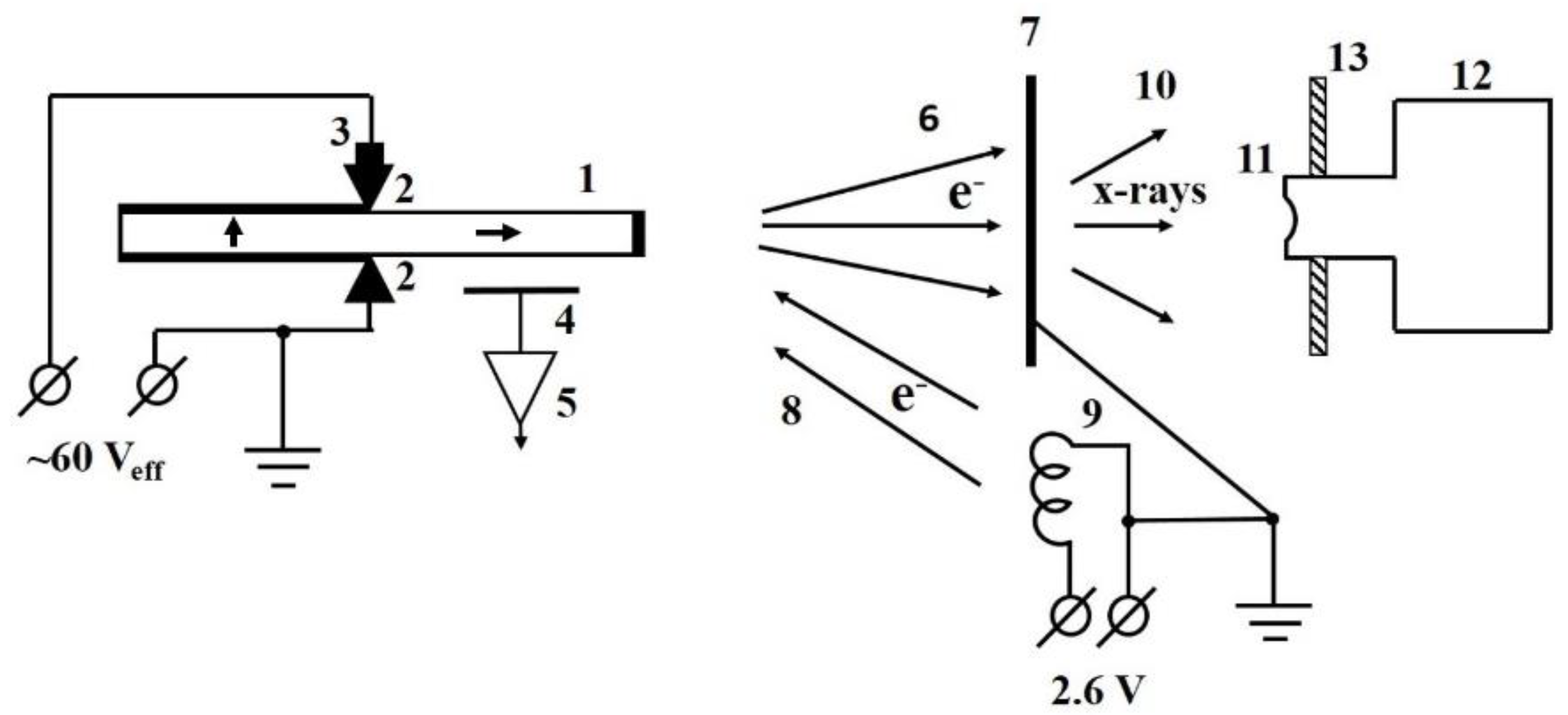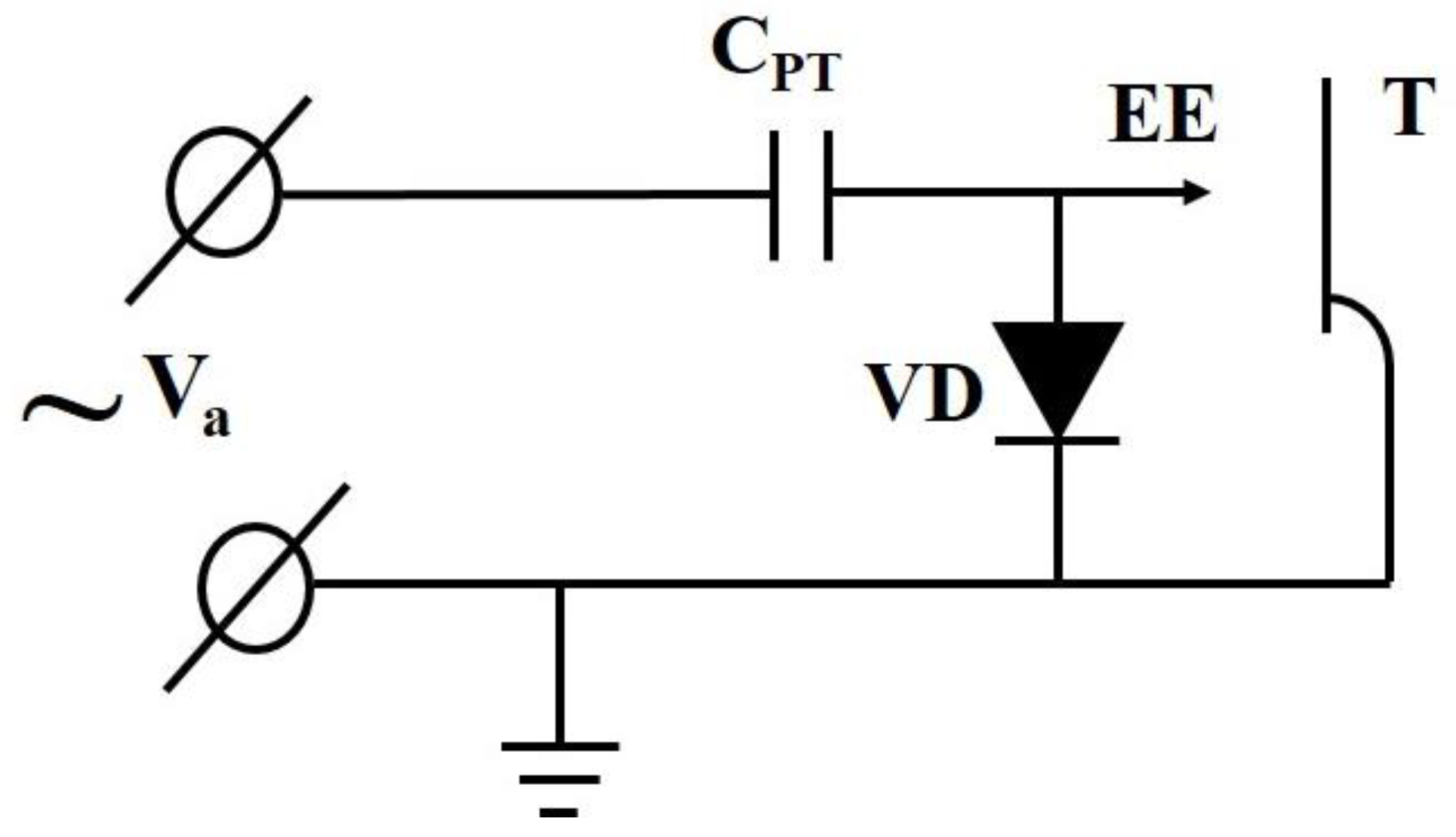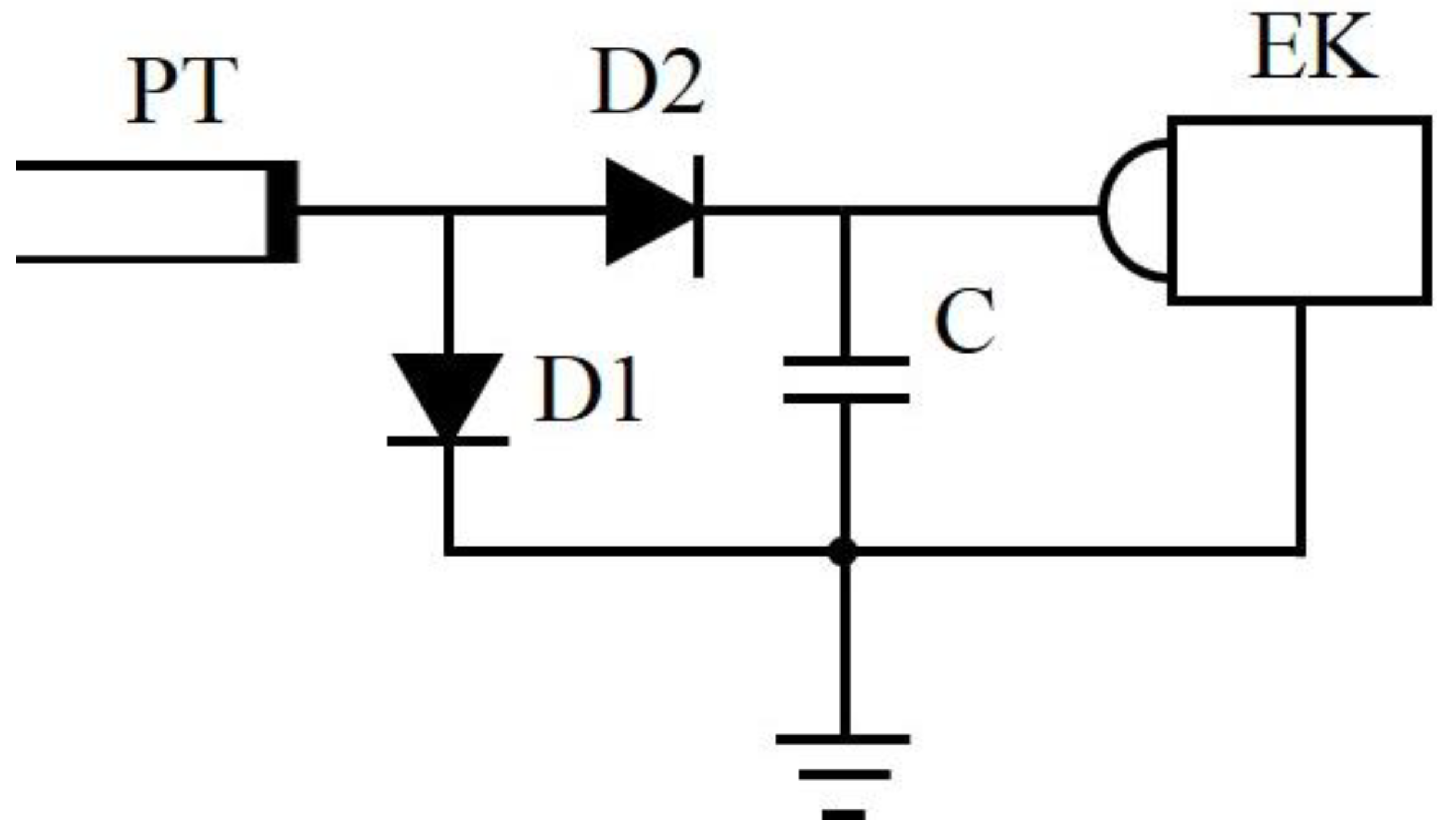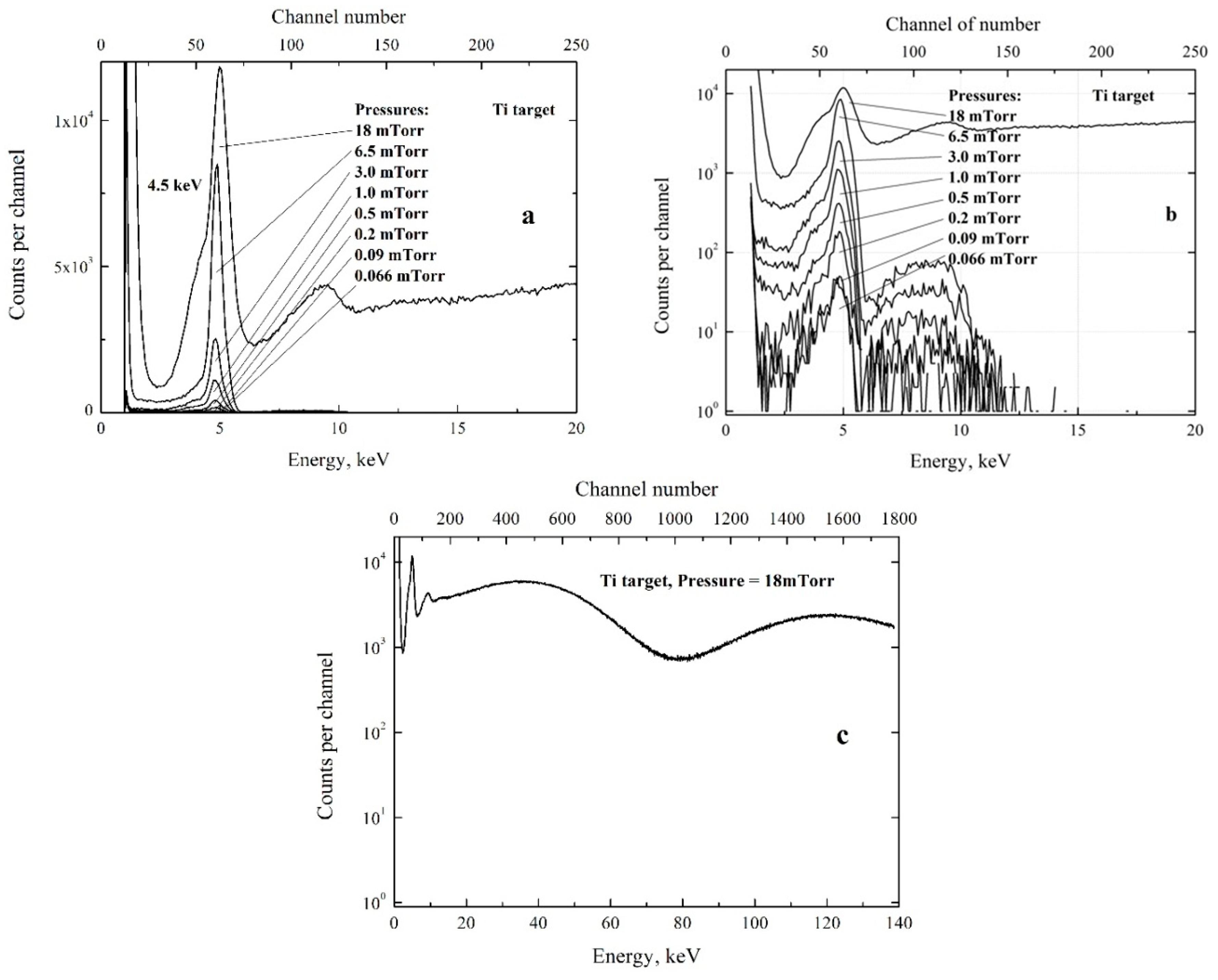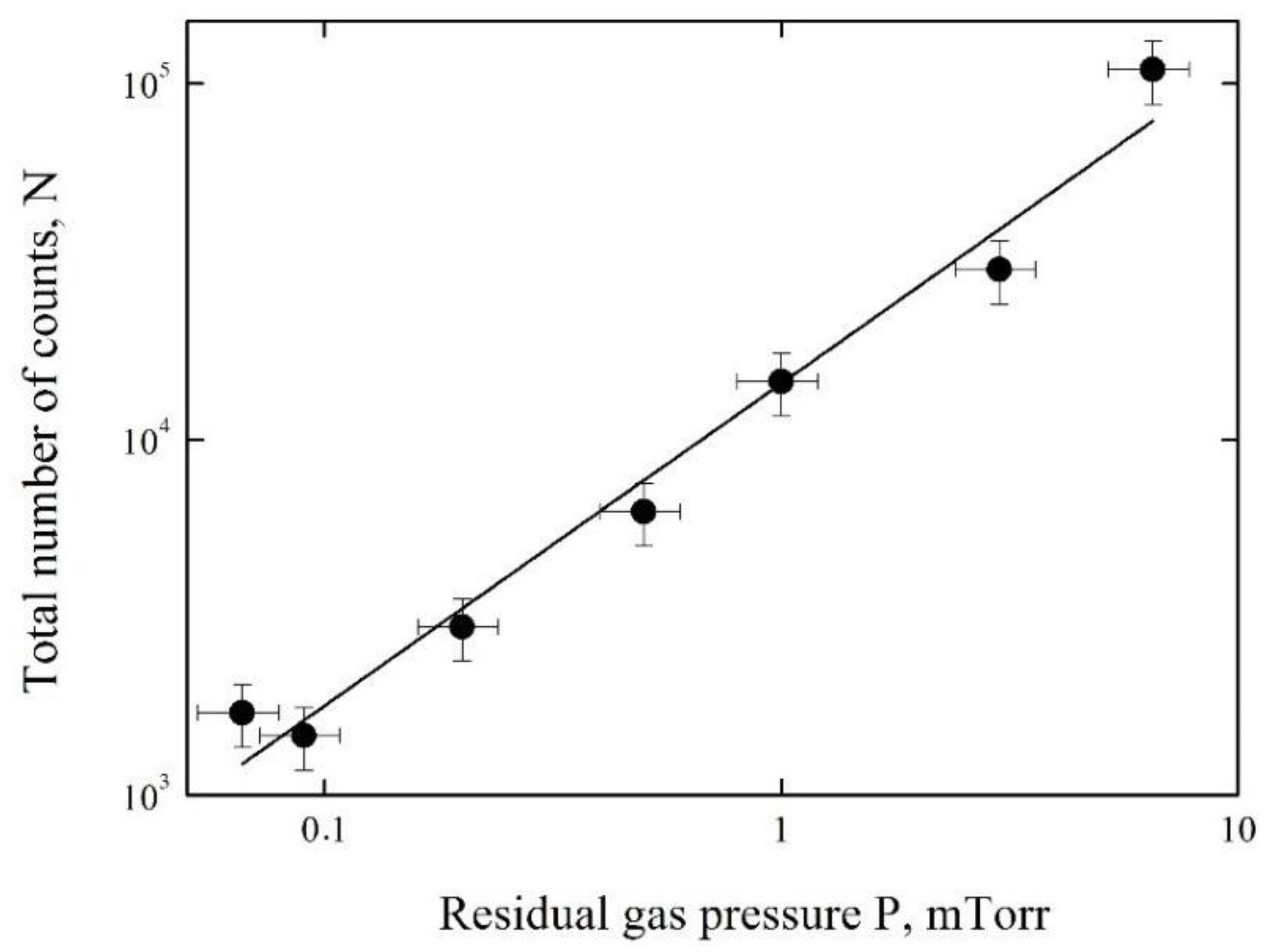2. Materials and Methods
Experiments were performed in the vacuum chamber of inner diameter 250 mm and height 300 mm. The scheme of the experimental setup in the vacuum chamber is shown in
Figure 1.
The Rosen type single layer piezoelectric transformer (Monolit, Vitebsk, Belarus) made of ceramics based on lead zirconate titanate was used in the experiment. According to producer’s specification, the basic resonance frequency of the transformer is 19–22 kHz, the input capacity is 1800–2300 pF, the output capacity is 7–9 pF, the output voltage is no less than 3.0 kV and input current no more than 20 mA at input effective voltage 20 V and 100 MΩ loading resistor, the coefficient of efficiency is no less than 0.5 at 30 MΩ loading resistor, and the maximum input voltage is 60 V. The bar size is 80 mm × 10 mm × 3 mm. The piezoelectric transformer was clumped up in vacuum between two spring-loaded contacts in the middle of the bar (see
Figure 1) and operated at first harmonic with resonance frequency close to 20 kHz. The power supply of the transformer was provided by an outer generator, which produces the sine signal of effective voltage 60 ± 0.5 V of resonance frequency. The frequency of the generator smoothly tuned to find the resonance frequency of the piezoelectric transformer. No special electron emitter was installed at high voltage electrode of the transformer, but electrons could be emitted from the surface irregularities of the electrode in the electric field between the electrode and grounded target. The target made of 20 µm thick titanium foil was installed at the distance of 30 mm from the high voltage electrode. The filament was installed near the target. The glower of 3.5 V 0.28 A incandescent lamp with removed glass bulb was used as the filament.
To study acceleration of electrons, we observed X-rays excited by accelerated electrons in a thin target. Spectra of X-ray radiation were measured with the X-ray spectrometer (Amptek, Bedford, MA, USA) that consists of the 5 mm × 5 mm × 1 mm CdTe X-ray detector XR-100T and the digital pulse processor PX-4 [
12] connected to a laptop. The peaking time of the spectrometer was 4 μs. The X-ray spectrometer was energy calibrated with radioactive sources
55Fe and
241Am. The energy resolution of the X-ray spectrometer (FWHM) was about 420 eV at X-ray energy of 5.9 keV. The 100 µm thick beryllium entrance window of the detector was sunk into the vacuum chamber. The distance between the entrance window and the target was 6 mm.
Electrons emitted from the high voltage electrode are accelerated toward grounded target during negative half-wave of voltage at the high-voltage electrode of the transformer. However, the emission of electrons from the high-voltage electrode of the piezoelectric transformer leads to the increasing of average positive potential at the electrode and the reduction of an energy of accelerated electrons [
8]. To avoid the reduction, one has to provide returning of a negative charge to the high voltage electrode of the piezoelectric transformer [
8]. The application of the vacuum diode for the returning of the charge has been proposed in communication [
11]. The equivalent scheme for explanation of the electron current return path is shown in
Figure 2.
The sinusoidal high voltage of amplitude
is produced at the high voltage electrode of the piezoelectric transformer with output capacitance
and penetrates to the vacuum diode VD and electron emitter EE. The surface irregularities at the high-voltage electrode of the ceramic piezoelectric transformer were used as electron emitters in our experiment. The cathode of the vacuum diode VD is the grounded filament (see
Figure 1). The filament emits electrons and provides the electron current to high voltage electrode of the piezoelectric transformer during the positive half-wave of the voltage. As a result, the negative pulsed sinusoidal voltage arises at the electron emitter. The average value of the voltage is
. The maximum negative voltage 2
appears at the emitter EE with the frequency of the operation of the piezoelectric transformer. The electrons emitted in the moments of the maximum voltage 2
are accelerated and strike the grounded target with energy 2
e, where
e is the electron charge. To verify the voltage, well known scheme of the voltage doubler shown in
Figure 3 was used.
The scheme shown in
Figure 3 was assembled in the air with semiconductor diodes D1 and D2. The DC positive voltage of value 2
is produced at the output capacitor C. The piezoelectric transformer operated in the same regime as in vacuum (input AC effective voltage 60
at the resonance frequency about 20 kHz). The measured voltage 12 kV is in agreement with maximum observed energy of X-rays, 12 keV (see
Figure 4). It means that the piezoelectric transformer produces the same voltage in air and in vacuum.
The piezoelectric transformer heats at its operation with resonance frequency. However, the temperature regimes of operation of the piezoelectric transformer in vacuum and in air are different. In air, the piezoelectric transformer is cooled mainly by air. In vacuum, the cooling is possible mainly due to thermal radiation and partially through the contacts. The semiconductor digital thermometer DS18B20 was installed on one of the contacts (see
Figure 1) to estimate the temperature of the piezoelectric transformer.
The resonance frequency of the piezoelectric transformer in vacuum somewhat changed in time after turning on because of the heating of the ceramics. Therefore, fine tuning of the generator frequency was executed to provide resonance conditions during measurements of every spectrum.
To control resonance conditions, the electric field probe (cupper strip) was installed at distance of about 1 cm from the high-voltage part of the piezoelectric transformer. The sinusoidal signal from the probe was amplified and observed by an oscilloscope. The resonance frequency was at maximal amplitude of the sine signal from the probe.
3. Results
All spectra of X-ray radiation were measured during 5 min at different pressures of the residual gas (air) in the chamber. During every measurement, the temperature measured at one of the contacts of the piezoelectric transformer increased from 35 °C to about 60 °C while the resonance frequency increased by about 150–200 Hz and the amplitude of sine signal from the electric field probe decreased by about 10–15%. The frequency of the generator was smoothly tuned during the measurements to provide maximum signal from the electric field probe and resonance conditions as described above. The spectra measured at different pressures of the residual gas in the chamber are shown in
Figure 4.
From the beginning, let us consider all spectra shown in
Figure 4a,b measured at the residual gas pressure 0.066 ≤ P ≤ 6.5 mTorr (0.0088 ≤ P ≤ 0.87 Pa). The spectra have the same shape but the yields are different. Every spectrum has spectral peak at energy 4.5 keV with background of bremsstrahlung radiation. The peak energy corresponds to the
line of titanium atoms composing the target. The sharp decrease of the background yield at X-ray energies some exceeding 5.0 keV corresponds to the sharp increase of the attenuation of X-rays in the Ti target at energies some exceeding the K-edge of attenuation of Ti atoms at 5.0 keV. The maximum energy of the bremsstrahlung is about 12 keV in all spectra. The maximum energy of accelerated electrons should some exceed the maximum energy of the bremsstrahlung. This means that X-rays are produced in the target by electrons with maximum energy close to 12 keV. The maximum energy of the accelerated electrons of 12 keV is practically independent of the pressure.
One can see strong increase of the number of counts in the high-energy part of the spectrum measured at pressure 18 mTorr (2.4 Pa). During this measurement, the appearance of visible light around of the piezoelectric transformer was observed through the glass window of the chamber. The emission of the light was due to gas discharge in the pulsed electric field in the vicinity of the piezoelectric transformer. The acoustic vibration from the piezoelectric transformer could pass through the discharging gas and reach the detector. Besides, similar spectra were observed at much lower pressures if the piezoelectric transformer was shifted and contacts were not exactly in the middle of the transformer bar, where the node of transformer at first harmonic is located. In this case, the acoustic vibrations passed from the piezoelectric transformer through the contacts, the holder of the contacts, and the vacuum chamber walls to the detector. The appearance of the acoustic vibrations in the detector was observed with use of the oscilloscope connected to the exit of the preamplifier of the detector in the view of the 20 kHz sinusoid. Considering the significant sensitivity of CdTe detectors to the acoustic noise, one can conclude that high-energy part of the spectrum measured at 18 mTorr arises not due to X-rays but because of the acoustic noise from the piezoelectric transformer.
The measured X-ray yield as a function of the residual gas pressure is shown in
Figure 5. The yield is given in units of the total number of counts
N registered in the spectra at 0.066 ≤ P ≤ 6.5 mTorr.
The approximation of the experimental data was obtained by the method of least squares in the view of the linear function
where
P is the pressure in mTorr units. The results of calculations by Equation (1) are shown by the solid line in
Figure 5. One can see that the X-ray yield increases practically linearly in the pressure range from 0.066 to 6.5 mTorr. This means that the current of accelerated electrons increases practically linearly with increase of the pressure.
